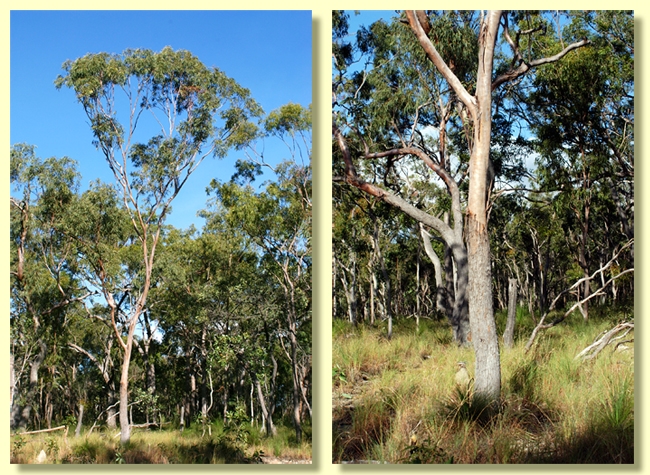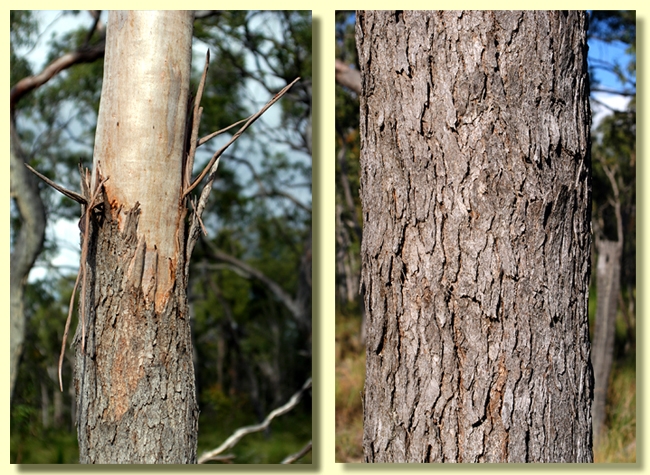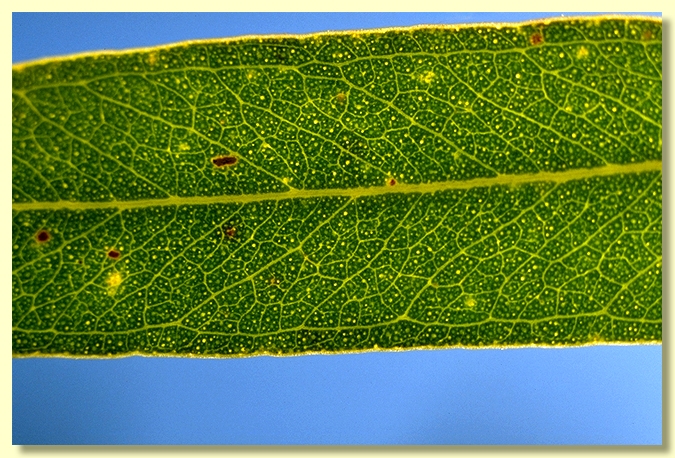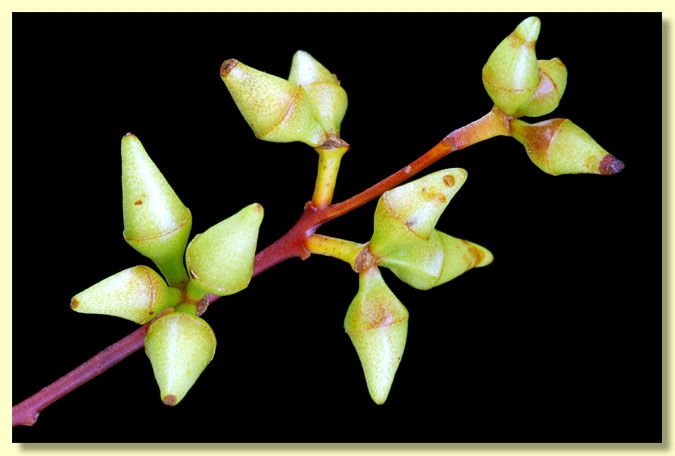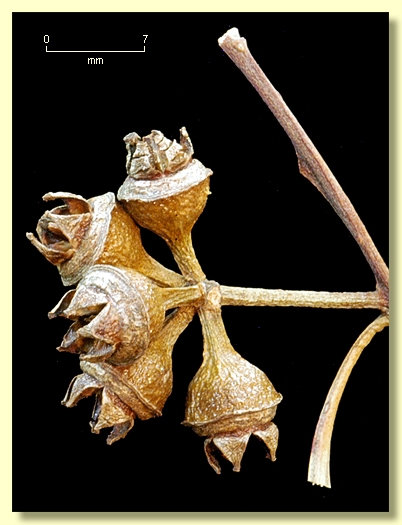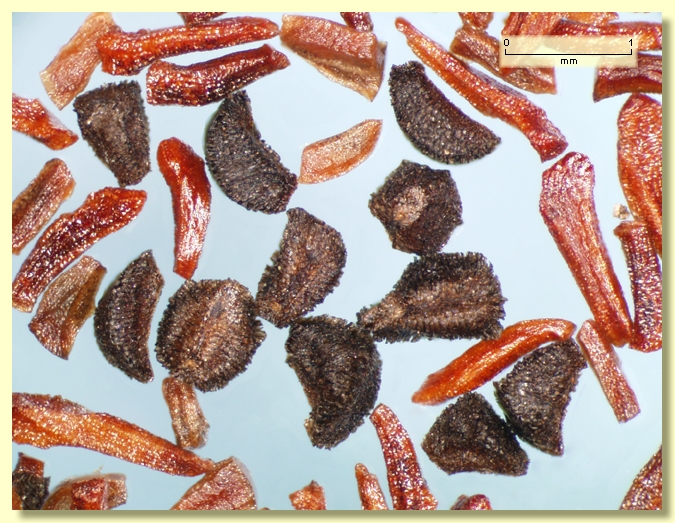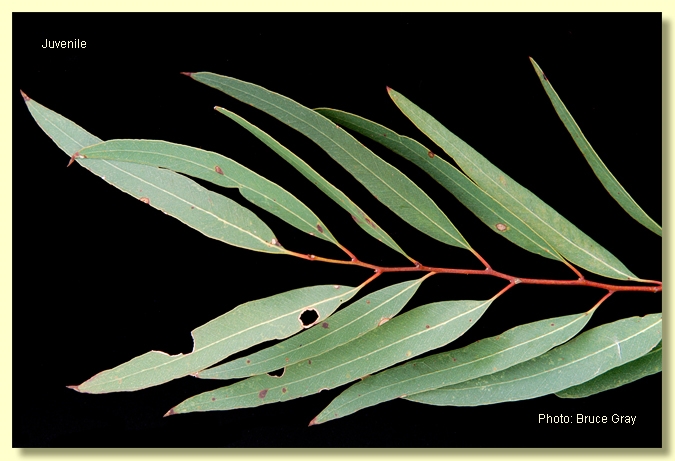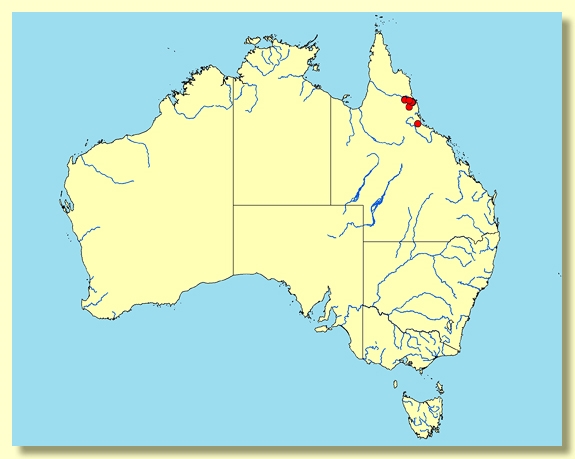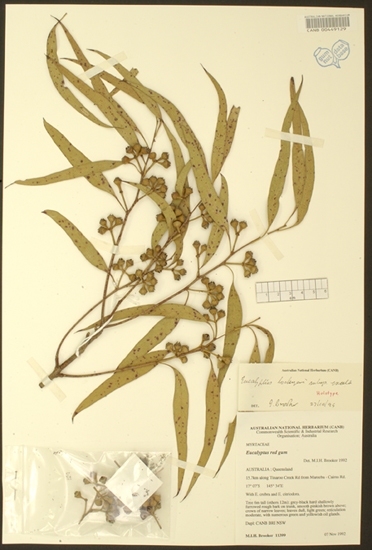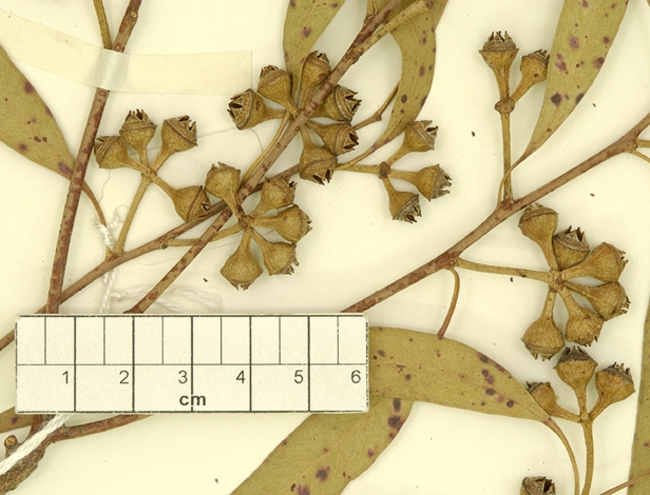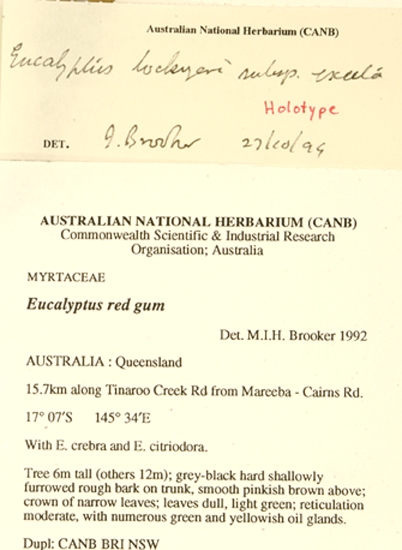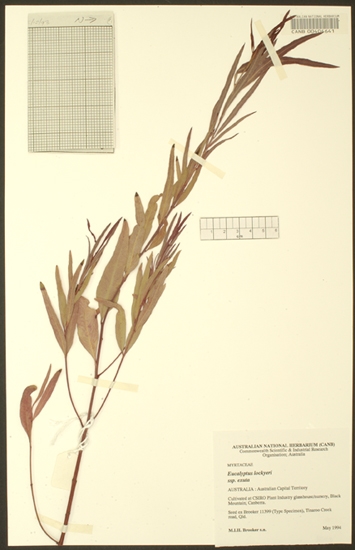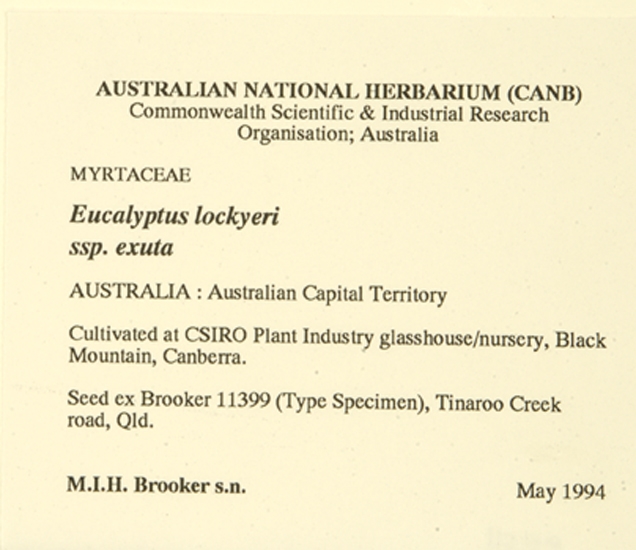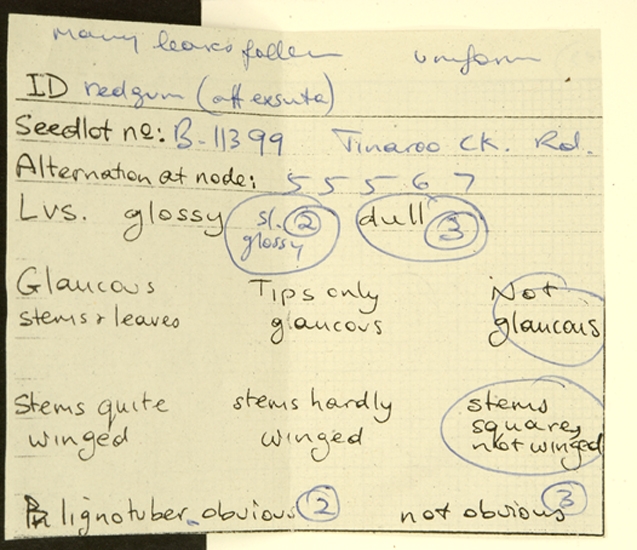Eucalyptus | Symphyomyrtus | Exsertaria | Phaeoxylon
Euclid - Online edition
Eucalyptus lockyeri subsp. exuta
[Nicolle & Jones (2018) assert Eucalyptus insulana F.M.Bailey, hitherto regarded as a synonymous with Eucalyptus exserta F.Muell., is in fact the same as E. lockyeri subsp. exuta Brooker & Kleinig, and is therefore the legitimate name having been published earlier. Nicolle & Jones offer no supporting discussion. Having inspected types of all 3 taxa and being familiar with E. lockyeri subsp. exuta and Eucalyptus exserta in the field I conclude that E. insulana does not equal E. lockyeri subsp. exuta but is a form of E. exserta. A.Slee, October 2018]
Small to medium-sized tree to c. 12 m tall, sometimes mallee-like. Forming a lignotuber.
Bark rough on part or all of trunk, fibrous to flaky, sometimes hard and compacted, dark grey to black. Upper trunk and large branches with pink-brown to red-brown to green-brown to coppery smooth bark.
Juvenile growth (coppice or field seedlings to 50 cm): stem square or rounded in cross-section, not glaucous; juvenile leaves shortly petiolate, alternate, narrowly lanceolate to lanceolate, 5.5–7.5 cm long, 0.9–1.6 cm wide, dull green.
Adult leaves alternate, petiole 1.2–2 cm long; blade lanceolate, 8–19 cm long, 0.8–2 cm wide, base tapering to petiole, concolorous, dull to slightly glossy, green, side-veins acute or at an angle greater than 45° to midrib, moderately reticulate, intramarginal vein parallel to the margin, oil glands island.
Inflorescence axillary unbranched, peduncles 0.5–1.5 cm long, buds 7 per umbel, pedicellate (pedicels 0.2–0.3 cm long). Mature buds ovoid (c. 0.8 cm long, c. 0.4 cm wide), smooth, scar present, operculum conical, stamens erect, anthers cuboid to oblong, versatile, dorsifixed, dehiscing by longitudinal slits (non-confluent), style long, stigma tapered, locules 4(5), the placentae each with 6 vertical ovule rows. Flowers white.
Fruit pedicellate (pedicels 0.3–0.5 cm long), hemispherical, 0.3–0.4 cm long, 0.6–0.8(0.9) cm wide, disc raised, oblique to convex, valves 4(5), strongly exserted.
Seeds dark brown to black, 0.8–1.2 mm long, obliquely pyramidal to cuboid, dorsal surface pitted, hilum terminal.
Cultivated seedlings (measured at ca node 10): cotyledons reniform to oblong; stems square in cross-section, not glaucous; leaves sessile to shorly petiolate, opposite for 5 to 8 nodes, becoming alternate, narrowly lanceolate to linear, 5.5–8 cm long, 0.5–1.5 cm wide, base tapering, apex pointed, dull to slightly glossy green.
Flowering time unknown.
A small to medium-sized tree, endemic to North Queensland. Known only from three populations, from the hills just south-east of Mareeba, the Mt Mulligan area north of Dimbulah and recently found just north of Townsville in the area west of Paluma. Eucalyptus lockyeri subsp. exuta is characterised by its tree habit, the rough bark on the base of the trunk, the conspicuous smooth bark on the upper trunk and large branches, its non-glaucous buds, fruit and juveniles; it is often found on rhyolite.
Eucalyptus lockyeri subsp. exuta belongs to a group of red gums that is distinguished by having rough bark, buds with the stamens mostly erect, fruit where the disc is united to the ovary roof and by the dark brown to black, toothed, cuboid to pyramidal single-coated seed. This group has six taxa occurring from central New South Wales north to New Guinea. They are E. brassiana, E. lockyeri subsp. lockyeri, E. lockyeri subsp. exuta, E. ammophila, E. exserta and E. morrisii. Within this group E. lockyeri subsp. exuta is probably closest to E. exserta and E. brassiana. It differs from E. exserta by the amount of rough bark on the trunk and large branches. E. exserta is usually fully rough-barked to the small branches while E. lockyeri subsp. exuta is only rough-barked on the lower trunk, with the upper trunk and large branches conspicuously smooth-barked. E. brassiana is very similar in bark characters to E. lockyeri subsp. exuta. It differs by having slightly larger fruit (0.6–0.8 cm wide in E. lockyeri subsp. exuta and 0.7–1.2 cm wide in E. brassiana) and broader juvenile leaves (0.5–1.6 cm in E. lockyeri subsp. exuta and 3–7 cm wide in E. brassiana). E. lockyeri subsp. lockyeri is distinguished by its glaucous adult leaves, buds and fruit (adult leaves, buds and fruit for subsp. exuta, not glaucous).
E. ammophila is distinguished by its mallee habit and by its preference for growing on sand plains (E. lockyeri subsp. exuta is normally a tree which has only been found on hills in poor soil). E. morrisii is from central New South Wales and can be distinguished by having three-budded umbels (always seven-budded in E. lockyeri subsp. exuta ).
There are two subspecies:
E. lockyeri subsp. lockyeri
Distinguished by having glaucous leaves, buds and fruit.
E. lockyeri subsp. exuta
Is very similar in bark characters to subsp. lockyeri, with at least 1–2 m of rough bark on the trunk and then smooth reddish-brown bark above that. It can be easily distinguished by its lack of glaucescence (visible wax) on the leaves, buds and young fruit.
Eucalyptus lockyeri: after Michael Lockyer of Ravenshoe, Queensland, who has a keen interest in the flora of the Atherton Tableland and who first drew the authors' attention to this taxon.
subsp. exuta: Latin exuta, cast off, shed, referring to the lack of glaucescence on all parts, as opposed to E. lockyeri subsp. lockyeri which has glaucous buds, fruit & juveniles.

